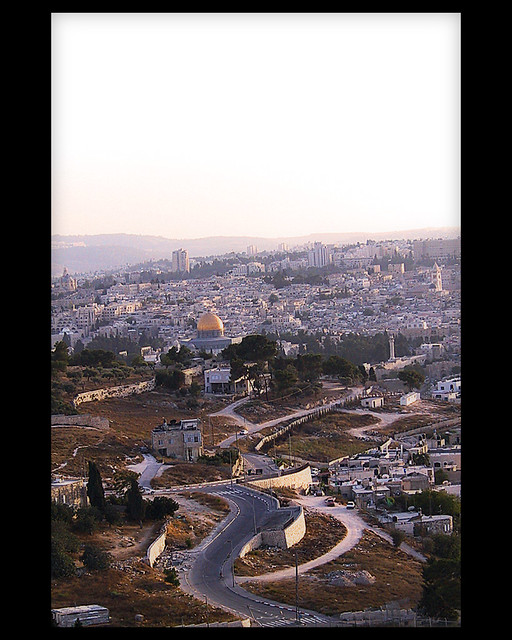
© 2002 blhphotography, Flickr | CC-BY | via Wylio
(This post was originally published during the 2008 Israeli invasion of the Gaza Strip, but it includes broader resources on the conflict and is regularly updated, including the 2021 conflict. Explainers about what’s happening in 2021 are located at the bottom of this post. ADDENDUM: Now, materials for the 2023 conflict can also be found at the bottom)
I’m emphasizing the quotation marks surrounding the word “Best” in the title of this post. In light of what is happening in Gaza and Israel right now, and its potential for even greater violence, I thought I would begin to put together some resources that would be handy when we go back to school in a week.
I’ll certainly be adding more to this list as time goes on, but at least it’s a start.
It’s not that easy finding good material out there that’s accessible to English Language Learners, which is a requirement for anything to be included in a “The Best…” list or, in fact, for pretty much anything that I post about here. I’m hopeful of finding better, and more up-to-date, resources as time goes on. It’s especially difficult to find accessible materials that provide some kind of historical context for the conflict. It’s complexity, and its potential for controversy, probably doesn’t make it that attractive a subject for many of the usual “current events” providers of content to younger readers.
You might also be interested in The Best Posts & Articles On How To Teach “Controversial” Topics.
Here are my picks for The “Best” Resources For Learning About the Israeli-Palestinian Conflict (not in order of preference):
The CBBC Newsround has some materials very accessible to English Language Learners, though some are out-of-date. The resources are about what is happening now as well as what has happened in the past
The Peace Research Institute In The Middle East (PRIME) is an organization comprised of Israelis and Palestinians who have developed high school materials on the Middle East that are used in both communities. As a Newsweek article explains, each page is divided into three: the Palestinian and Israeli narratives and a third section left blank for the pupil to fill in. “The idea is not to legitimize or accept the other’s narrative but to recognize it..”
All the PRIME materials can be freely downloaded from their site. They are far too advanced for English Language Learners, but the idea can used with modified materials about the Middle East conflict. In fact, I think it would be fairly easy to do so with some of the resources already on this list.
Locked In Gaza is a New York Times slideshow and Growing Up In Gaza is a Times’ video.
The BBC has a good map of the Israeli and Palestinian “territory.”
Changing map of Israel and the Palestinian territories is from The Guardian.
Challenges in Defining an Israeli-Palestinian Border is an interactive from The New York Times.
Interactive: Gaza, life under siege is from Al Jazeera.
11 crucial facts to understand the Israel-Gaza crisis is from Vox.
The Crisis In Gaza is an interactive from The Washington Post.
2021 Conflict Resources:
Israel-Gaza violence: The conflict explained is from The BBC.
Explainer: How did the latest Israeli-Palestinian crisis emerge? is from NBC News.
Israel-Palestine crisis explained: why has the violence escalated again? – video is from The Guardian.
Teaching About the Current Conflict in Gaza and Israel is from The NY Times Learning Network.
2023 Conflict:
The Israeli-Palestinian conflict: A chronology is from The Washington Post.
What is the Gaza Strip? Who controls it? Here’s what to know is from NBC News.
Hamas has launched an unprecedented attack against Israel. Here’s what to know is from CNN.
What is Hamas, and why did it attack Israel now? is from The Washington Post.
How to Talk About the Israel-Hamas War: Resources for Educators is from Ed Week.
Processing Attacks in Israel and the Outbreak of War in the Region is from Facing History.
What is Hamas? What to know about the group behind the deadliest attack in Israel in decades is from NBC News.
“MAP EXPLAINER: THE GAZA STRIP”
Teaching About the Israel-Hamas War is from The NY Times Learning Network.
My students asked if I was ‘Team Israeli’ or ‘Team Palestinian.’ Here’s what I said. is from Chalkbeat.
The Israel-Gaza war: News literacy lessons is from The Washington Post.
And educators. https://t.co/nD4AQkkDqB
— Jennifer Binis (@JennBinis) October 19, 2023
How we talk about the Israel-Hamas war https://t.co/gxbio3ddFT
— Vox (@voxdotcom) October 24, 2023
A student asked a NYC teacher which side she’s on in the Israel-Hamas war. Here’s what she said https://t.co/5COtV9gN98
— Larry Ferlazzo (@Larryferlazzo) October 27, 2023
Gaza: the history of an embattled territory is an interactive from The Financial Times.
Students Are Bringing Up the Israel-Hamas War in Class. Here’s How Teachers Are Responding is from Ed Week.
Six maps explain the boundaries of Israel and Palestinian territories is from The Washington Post.
How Teachers Can Talk About The Israel/Hamas Conflict is from The Hechinger Report.
Centering Humanity While Following News of the Israel-Hamas War is from Facing History.
For more coverage about this topic, highly recommend @MichaelElsenRoo recent story about the divergent approach NYC high schools have taken to talking about the Israel-Hamas war at school (or not talking about it) https://t.co/0MmEJPS5g6
— Kalyn Belsha (@kalynbelsha) December 13, 2023
AP Human Geography is one of the rare classes that taught about the history of the Israeli-Palestinian conflict long before this year. Here’s how one veteran geography teacher sets ground rules for having discussions about conflicts in her classroom https://t.co/6thmavI0j9
— Kalyn Belsha (@kalynbelsha) December 13, 2023
Addressing Islamophobia and Anti-Semitism in K–12 Schools is from Edutopia.
At These Schools, Arab and Jewish Students Share Their Feelings, With Each Other via @NYTimes https://t.co/Pd4pCwVpvf
— Larry Ferlazzo (@Larryferlazzo) December 31, 2023
Here’s what to know about the Houthis, a Yemeni rebel group backed by Iran, who have launched dozens of attacks on ships sailing through the Red Sea and the Suez Canal since the Israel-Hamas war began. https://t.co/sknydcOAZu
— The New York Times (@nytimes) January 12, 2024
As tensions flare over Israel-Hamas war, NYC to train educators on having ‘difficult conversations’ is from Chalkbeat.
New Resources for Teaching About the Israel-Hamas War is from The NY Times Learning Network.
Mapped: how Gaza war led to violence spreading around the Middle East is from The Guardian.
The Road to 1948 is from The NY Times.
New on @WashingtonPost: “Friends, family, acquaintances: What would have happened to them if Gaza was home?” https://t.co/NpokcwG4Lt
— Interactive Journalism (@InteractiveFeed) March 25, 2024
I’m very interested in getting feedback and additional suggestions. Please leave them in the comments section of this post.
If you found this post useful, you might want to look at previous “The Best…” lists and also consider subscribing to this blog for free.



Hi Larry! First, I’d like to thank you for the wonderful blog you’ve put together. Awesome! 🙂
Regarding this particular post, however, I don’t think the sources you’ve mentioned are the “best” sources, even though I’m sure you sincerely thought they are.
Mainly your sources tell the American-government-approved version of the story, which I consider to be highly biased. Funny how those who have all the weapons and are armed to the teeth are always acting out of self-defense or to avoid further bloodshed (killing lots of people but “ultimately saving more lives than were taken”), and those who are actually being killed are always the terrorists and to blame.
Similar reasons were given for the American government’s bombings of Japan in the World War, and for the more recent killings in Afghanistan and Iraq. But, Larry, the truth is that hundreds of innocent civilians are being killed in Gaza, and the rest are being starved to death. I just don’t see how that can be justified by people who favor peace and understanding.
Hi Susan, I am in the process of blogging about Israel and Gaza, trying to get Americans to think and talk about what is happening, and take some personal responsibility in deciding what our government funds (eventually, I believe, the citizenry can affect what our government does, but we have to get mobilized on the issue) What resources would you suggest? Before the latest attacks, I was especially interested in the health and nutrition issues in Gaza and the West Bank (esp for women and children), more specific information than I’ve been able to find at the UN or WHO sites. Since the attacks, I’ve been concentrating on getting information out about that. I’m taking a humanitarian approach, because I believe that is what Americans will be most receptive to. Anyway, any help you could give me would be appreciated. Thanks! My email is: ellenpham@msn.com